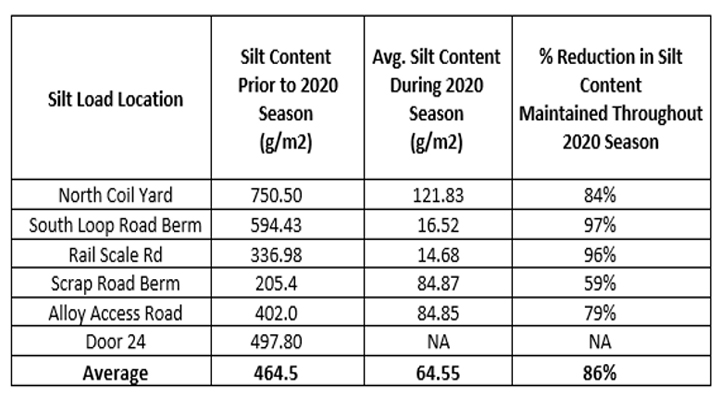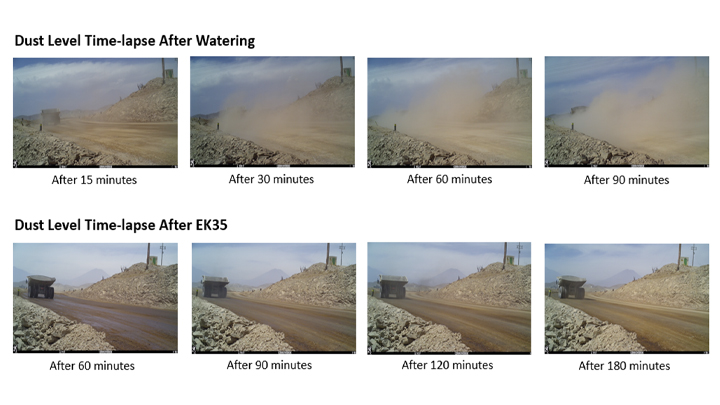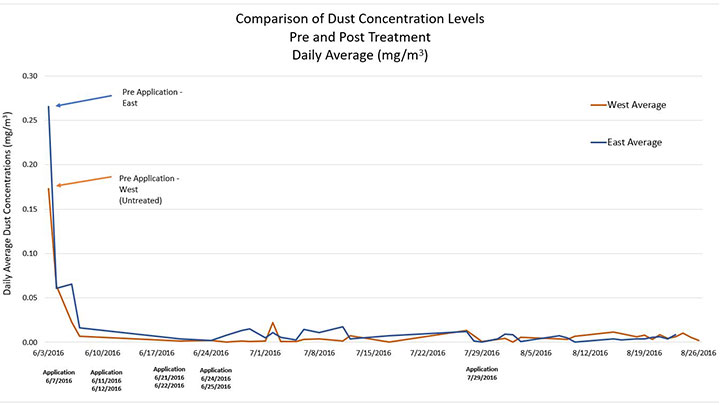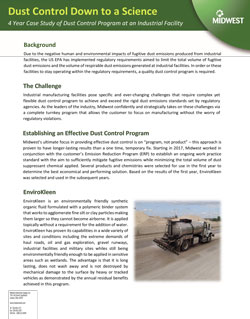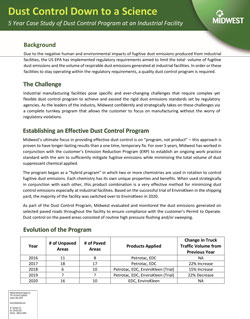Our new manufacturing cell at our Canton, Ohio headquarters is the next step in our history of technology and innovation leadership in dust control, soil stabilization, rail lubrication, and anti-/deicing. The new cell will manufacture Midwest’s leading dust control and soil stabilization products: EK35®, EnviroKleen® and MineKleen® Plus. Read more about our new manufacturing cell.
Nothing left to chance. Everything demonstrably proven.
FACT: You have a dust problem.
Most major industrial operations have inherent dust issues, which is why they are required to operate within strict air quality permits such as Title V Air Quality Permits or OSHA Silica Rule. If you’re responsible for a steel mill, precast operation, quarry or mine, then you are particularly prone to particulate matter pollution. If you're a campground, vineyard, ranch, or other lighter road operation, dust can impact your visitors' health, your grapes, or your animals. And if you maintain gravel roads, you're probably exhausted from residents' complaints about the airborne dust.
FACT: Watering doesn’t work and you pay more than you think.
Compared to Midwest’s functional dust control of up to 95%, water at best is only 50%. However, water is the ultimate in temporary solutions because it evaporates quickly. Plus, the more frequent the application, the more people and machinery needed, the more congestion caused, the more runoff and unstable driving surfaces and the more road maintenance required. All this material, labor and long-term problems make a seemingly “cheap” resource like water cost more than you think.
FACT: Other dust control products are costly and limited in effectiveness.
Many companies have tried everything to control dust, from chlorides to lignin sulfonates to off-the-shelf chemicals. Either the product is toxic for the environment and corrosive to vehicles like chlorides, or it doesn’t get lasting results like lignin sulfonate products. Those that tried lignosulfonates got tired of messing with the sticky, black substance and all of the mounting costs (the chemical itself + water to dilute it + extra manhours to clean it off equipment + lost productivity navigating around tanker trucks).
FACT: Only Midwest’s site-customized full program gets proven results.
Midwest’s customers have come to expect results like up to 95% dust control and 95% reduction in water usage, up to 75% reduction in grading compared to water, better utilization of personnel and equipment, the elimination of excessive water-related operating issues requiring road maintenance — and more. Employees stay healthier, residents are happier, crops produce more abundantly and taste better — all because Midwest has dust control down to a science!
Our success metrics are your success metrics.
Down to a science means right at the site.
One of the main keys to Midwest’s success in proven dust control is a program instead of just a product. Moreover, a Midwest program is site-specific. Site strategies are developed for a particular site based on studying that site. By strategically planning maintenance applications as supported by field data and observations, we are able to improve the efficiency of our dust control program, as established by credible evidence of performance. We quantify and document the value that’s delivered with Midwest’s dust control programs. You deserve to know the real cost of dust control, and we provide it, in terms of cost-per-square foot, time duration, and targeted control efficiency. Here’s how it works:
BEFORE THE DUST CONTROL PROGRAM
- Initial site assessment and walk-through to diagnose a customer’s current dust levels and site conditions
- Determine areas to be treated and define each area's square footage
- Select the best product and program for each site (i.e., customer-applied vs. delivery and applied)
- Conduct baseline performance testing: VEO, Silt Load, Visual Assessment, etc.
DURING THE DUST CONTROL PROGRAM
- Record location, data, and gallons applied for each application
- Conduct routing performance monitoring: VEOs, Silt Loads, Visual Assessments, etc.
- Coordinate maintenance applications with MIS and customer based on performance
AFTER THE DUST CONTROL PROGRAM
- Compile and analyze all performance data, application information, and field observations
- Write annual performance report
- Present report and findings to customer
The proof is in the toolbox.
Midwest Dust Control Down to a Science uses a full performance monitoring toolbox of methodologies to measure performance and report outcomes. This provides you with verified proof of the value delivered by your dust control program.
Midwest’s field team collects field performance data to verify the laboratory’s designs and provide credible evidence of performance. Years of performance monitoring data has been collected to improve the efficiency of Dust Control Down to a Science; strategically plan maintenance applications; quantify and document the value of the program; and confirm the customer has met all regulatory compliance requirements.
> Indicates best timing for maintenance applications
> Follows US EPA Method 9 procedure for instantaneous opacity readings of dust plumes generated from traffic
> Performed by trained/certified opacity observers, with readings recorded in 5% increments
> Determines daily maximum, daily minimum and average concentrations
> Indicates best timing for maintenance applications
> Measurements by forward light scattering technology collects large data sets to assess trends and identify changes over days/weeks/seasons
> Visual assessments of the surface to identify, photograph and document surface deterioration, dust levels and overall performance by trained Midwest personnel
> Assess change in performance and conditions for potholes, rutting, based/subgrade exposure, product leaching, aggregate segregation and gravel float, rough/damaged areas, standing water
> Compares interval tests to baseline using US EPA method of collecting loose surface material on representative cross section (1’ wide)
> Quantifies moisture content and volume of material passing through #200 sieve determined in lab
> Creates visual comparisons of performance degradation over time
> Safely observes true operating conditions at multiple locations without having to be onsite
> Typically performed at mining facilities to determine impact of haul truck traffic on dust emissions
> A network of spatial air quality data points provides real-time roadside air monitoring to identify the exact sources of pollution
> Helps control structural uniformity, strength and deflection
> Promotes better smoothness and longer lasting pavement surfaces at lower cost
> Records the thickness and location of underlying soil layers
> Determines how soil strength varies with depth, critical to developing the best solution for unsuitable subgrade soils
Examples of Results
This is the kind of performance proof you get to show actual outcomes for your Midwest dust control program.
Real science. Real results.
Case Study #1 — Steel Operation
The Midwest value proposition was based on a Turnkey Managed Services Program involving dedicated Midwest Industrial Supply employees onsite for observation, data gathering and dust suppressant application. The goal was to maintain fugitive emissions from unpaved roadways and open areas to less than 15% instantaneous opacity.
Midwest also assisted the steel operation with pursuing compliance with the appropriate sections.
Results and Conclusions:
- Over 89% reduction in airborne particulate matter
- Over 90% season-long control levels
- Greater than 95% confidence
Case Study #2 — Diamond Mine
The Midwest value proposition was based on a Turnkey Managed Services Program involving dedicated Midwest employees onsite for observation, data gathering and dust control application. The goal was to reduce fugitive emissions by 80%+. As can be seen by the results, over 85% dust control was achieved. These results were confirmed using multiple methods.
Performance Testing & Monitoring Methods:
- Video Road Audits and Visual Emission Observations (VEOs) — video road audits were performed during each site visit using photos and videos of roadway surface conditions together with written roadway surface assessments
- Casella Roadside Dust Collection Monitors — used during varying days, locations and times to collection emissions data, which is analyzed to quantify level of control of emissions over time
- Silt Load Testing — performed pre- and post-treatment with data collected to quantify emissions reduction over time
More Dust Control Down to a Science Case Studies:
For 4-year and 5-year dust control case studies, download the following by clicking on the image below:
Independent proof of Midwest efficacy
Since 1975, Midwest has participated in dozens of independent third-party studies conducted by prominent government and private agencies to evaluate the effectiveness of Midwest’s solutions for emissions control compliance.
Through these field and laboratory evaluations, Midwest’s chemistries have been tested and proven in a multitude of different soils, climates and range of vehicles — from Bradley Fighting Vehicles, pickup trucks, 400-ton Kress steel hauling trucks, tractor trailers, slag haulers and more. Midwest has participated in the following major scientific studies for best dust control practices:
- US Army Corps of Engineers — Engineer Research and Development Center (1997, 2002, 2004, 2005, 2006, 2007, 2010, 2011, 2020)
- University of Alaska Fairbanks —– Alaska University Transport Center (2006, 2008, 2010, 2012, 2015)
- Desert Research Institute (1996)
- Midwest Research institute (1987)
- US Department of Agriculture (2008)
- US Environmental Protection Agency (1987, 2001, 2005, 2008)
- US Geological Survey (2012, 2015)
Testing in our own 5,000+ square foot geotechnical laboratory.
In addition to major 3rd party scientific studies, Midwest has decades of experience monitoring and conducting laboratory tests to diagnose, design, verify, and record the performance, longevity and effectiveness of our solutions.
- State-of-the-art equipment to perform testing in accordance with the American Society of Testing and Materials (ASTM) and American Association of State Highway and Transportation Officials (AASHTO) standards
- R&D to improve current and create future Midwest products
- Trained laboratory technicians with over 25 years combined experience in materials testing
- Test customer samples to determine the best solutions for each customer’s unique project
In-house testing includes:
- Atterberg Limits — ASTM D4318
- California Bearing Ratio (CBR) — ASTM D1883
- Dust Column Drop Test
- Moisture Absorption Testing
- Moisture Content Determination — ASTM D2216
- Particle Size Distribution (PSD) — ASTM D6913 and ASTM C136
- Proctor Testing — ASTM D698 and ASTM D1557
- Silt Load Testing
- Topical Application Evaluations
- Unconfined Compressive Strength (UCS) — ASTM D2166
- USCS Classifications — ASTM D2487
- Wind Tunnel Testing
Midwest is dedicated to ensuring satisfaction and compliance for each customer and facility. You get confidence, reliability, and accuracy from decades of experience in real world outcomes that show how our product chemistries interact with various soils and site conditions.
Midwest’s proven process brings dust control down to a science
Different projects require different solutions based on each site’s specific conditions and requirements. A comprehensive and customized program is created to guarantee optimum performance, regulatory compliance, safety, environmental concerns and customer satisfaction.
Discover
Midwest reviews the current details of your facility to establish the value realized with Midwest’s Dust Control Down to a Science Program.
Diagnose
Midwest will evaluate your facility’s specific dust control issues and needs through site audits and interviews with key facility personnel. This information identifies areas of concern, defines the objectives and determines the most appropriate program.
Design
Midwest uses 40+ years of experience, data, and product knowledge to co-develop the best performing, most cost-effective dust control program for your facility. Midwest selects the right product, application rates and application schedule to reach each site’s dust control goals and requirements.
Deliver
Whether a Guided Self-Applied or fully managed turnkey program is selected, Midwest will deliver on your goals and expectations by helping you achieve the desired results for exactly the price that was agreed upon at the outset.
If you're ready for some proven science to get real results, contact Midwest today!
